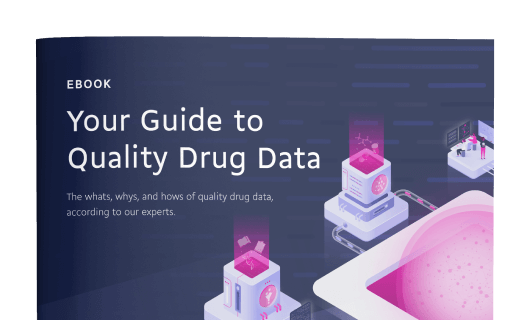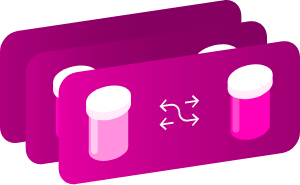Identification
- Summary
Daridorexant is a dual orexin receptor antagonist used to treat insomnia in adults.
- Brand Names
- Quviviq
- Generic Name
- Daridorexant
- DrugBank Accession Number
- DB15031
- Background
Daridorexant, formerly known as nemorexant, is a selective dual orexin receptor antagonist used to treat insomnia. Insomnia is characterized by difficulties with sleep onset and/or sleep maintenance and impairment of daytime functioning. It chronically affects the person's daily functioning and long-term health effects, as insomnia is often associated with comorbidities such as hypertension, diabetes, and depression. Conventional treatments for insomnia include drugs targeting gamma-aminobutyric acid type-A (GABA-A), serotonin, histamine, or melatonin receptors; however, undesirable side effects are frequently reported, such as next-morning residual sleepiness, motor incoordination, falls, memory and cognitive impairment. Novel drugs that target orexin receptors gained increasing attention after discovering the role of orexin signalling pathway in wakefulness and almorexant, an orexin receptor antagonist that improved sleep. Daridorexant was designed via an intensive drug discovery program to improve the potency and maximize the duration of action while minimizing next-morning residual activity.1
Daridorexant works on orexin receptors OX1R and OX2R to block the binding of orexins, which are wake-promoting neuropeptides and endogenous ligands to these receptors. Daridorexant reduces overactive wakefulness: in the investigational trials, daridorexant reportedly improved sleep and daytime functioning in patients with insomnia.1 It was approved by the FDA on January 10, 2022, under the name QUVIVIQ.6 as the second orexin receptor antagonist approved to treat insomnia following suvorexant.2 Daridorexant was approved by the European Commission on May 3, 2022, as the first dual orexin receptor antagonist approved in the market,8 and by Health Canada on April 26, 2023.9
- Type
- Small Molecule
- Groups
- Approved
- Structure
- Weight
- Average: 450.93
Monoisotopic: 450.1571017 - Chemical Formula
- C23H23ClN6O2
- Synonyms
- ACT-541468
- Nemorexant
Pharmacology
- Indication
In the US and Europe, daridorexant is indicated for the treatment of adult patients with insomnia characterized by difficulties with sleep onset and/or sleep maintenance.5,9 The European prescribing information states that insomnia should be characterized by symptoms that are present for at least three months and have a considerable impact on daytime functioning.7
 Reduce drug development failure ratesBuild, train, & validate machine-learning modelswith evidence-based and structured datasets.Build, train, & validate predictive machine-learning models with structured datasets.
Reduce drug development failure ratesBuild, train, & validate machine-learning modelswith evidence-based and structured datasets.Build, train, & validate predictive machine-learning models with structured datasets.- Associated Conditions
- Contraindications & Blackbox Warnings
 Prevent Adverse Drug Events TodayTap into our Clinical API for life-saving information on contraindications & blackbox warnings, population restrictions, harmful risks, & more.Avoid life-threatening adverse drug events with our Clinical API
Prevent Adverse Drug Events TodayTap into our Clinical API for life-saving information on contraindications & blackbox warnings, population restrictions, harmful risks, & more.Avoid life-threatening adverse drug events with our Clinical API- Pharmacodynamics
Daridorexant binds to and antagonizes the orexin receptors OX1R and OX2R (Ki = 0.47 and 0.93 nM, respectively) equipotentally.5 In clinical trials, daridorexant improved sleep onset and sleep maintenance, and patient-reported total sleep time. Patient-reported daytime sleepiness was also reportedly reduced.6 At a dose four times the maximum recommended dose, daridorexant does not prolong the QTc interval to any clinically relevant extent.5
Daridorexant is currently being assessed for a controlled substance schedule in the US. In a human abuse potential study, daridorexant showed some abuse potential at doses higher than the recommended dose (100-150 mg), indicated by similar “drug liking” ratings to zolpidem (30 mg) and suvorexant in recreational sedative drug users.5 However, at clinically relevant concentrations, daridorexant does not bind to abuse-associated CNS targets.1 In animal studies and clinical trials evaluating physical dependence, chronic administration of daridorexant did not produce withdrawal signs or symptoms upon drug discontinuation, indicating that the drug does not produce physical dependence.5
- Mechanism of action
The sleep and wake cycle is regulated by complex interactions between sleep-promoting systems, including inhibitory GABA activity, and wake-promoting systems, including orexins, acetylcholine and monoaminergic systems.2 Orexin, also called hypocretin, is a wake-promoting neuropeptide produced by a small group of neurons in the lateral hypothalamus.2 Orexin stabilizes wakefulness by activating orexin neurons with the highest activity during active wakefulness and minimal activity during sleep.1 Orexin neurons project to other wake-promoting neurons that also express orexin receptors: these include the histaminergic neurons of the tuberomammillary nucleus, noradrenergic neurons of the locus coeruleus, serotoninergic neurons of the dorsal raphe, dopaminergic neurons of the ventral tegmental area, and cholinergic neurons of the basal forebrain and the pedunculopontine and laterodorsal tegmental nuclei.1 These wake-promoting neurons are part of the ascending reticular activating system that operates under a feedback loop in the sleep and wake cycle.4
There are two identified types of orexin (OXA and OXB) that bind to orexin type 1 and 2 receptors (OX1R and OX2R), which are G-protein coupled receptors. OXA binds more preferentially to OX1R, while OX2R shows a dual affinity for OXA and OXB.4 The defined role of each orexin receptor is still unclear; however, there is some evidence suggesting that OX2R regulates sleep and wake, while OX1R have some role in sleep maintenance.2 Daridorexant blocks the binding of wake-promoting neuropeptides OXA and OXB to OX1R and OX2R, thereby suppressing wake drive.5 Daridorexant selectively targets orexin neurons and inhibits downstream neuronal pathways that promote wakefulness; however, it does not affect neuronal pathways that cause side effects commonly seen in positive allosteric GABA-A receptor modulators.1
Target Actions Organism AOrexin receptor type 1 antagonistHumans AOrexin receptor type 2 antagonistHumans - Absorption
Daridorexant reaches peak plasma concentrations within one to two hours. Daridorexant has an absolute bioavailability of 62%. While a high-fat and high-calorie meal delayed the Tmax by 1.3 hours and decreased the Cmax by 16% in healthy subjects, the total exposure (AUC) was not affected.5
- Volume of distribution
Daridorexant has a volume of distribution of 31 L. The blood to plasma ratio is 0.64.5 It effectively passes the blood-brain barrier.1
- Protein binding
Daridorexant is 99.7% bound to plasma proteins.5
- Metabolism
Daridorexant undergoes extensive metabolism primarily mediated by CYP3A4 (89%),5 mostly via oxidative transformations.3 Other CYP enzymes individually contribute to less than 3% of metabolic clearance of daridorexant.5
- Route of elimination
The primary route of excretion is via feces, accounting for approximately 57% of drug excretion. About 28% of the drug is excreted via urine primarily in the form of metabolites. Trace amounts of the parent drug were found in feces and urine.5
- Half-life
The terminal half-life is approximately 8 hours.5
- Clearance
There is limited information on clearance.
- Adverse Effects
 Improve decision support & research outcomesWith structured adverse effects data, including: blackbox warnings, adverse reactions, warning & precautions, & incidence rates. View sample adverse effects data in our new Data Library!Improve decision support & research outcomes with our structured adverse effects data.
Improve decision support & research outcomesWith structured adverse effects data, including: blackbox warnings, adverse reactions, warning & precautions, & incidence rates. View sample adverse effects data in our new Data Library!Improve decision support & research outcomes with our structured adverse effects data.- Toxicity
There is limited clinical experience with daridorexant overdose. In clinical pharmacology studies, healthy subjects were administered single doses of up to 200 mg, four times the maximum recommended dose. Somnolence, muscle weakness, cataplexy-like symptoms, sleep paralysis, disturbance in attention, fatigue, headache, and constipation were observed in these patients.
There is no specific antidote to overdosage of daridorexant. In the event of an overdose, general symptomatic and supportive medical care, along with immediate gastric lavage where appropriate, should be provided in addition to careful monitoring. Dialysis is unlikely to be effective as daridorexant is highly protein-bound.5
- Pathways
- Not Available
- Pharmacogenomic Effects/ADRs
- Not Available
Interactions
- Drug Interactions
- This information should not be interpreted without the help of a healthcare provider. If you believe you are experiencing an interaction, contact a healthcare provider immediately. The absence of an interaction does not necessarily mean no interactions exist.
Drug Interaction Integrate drug-drug
interactions in your software1,2-Benzodiazepine The risk or severity of CNS depression can be increased when 1,2-Benzodiazepine is combined with Daridorexant. Abametapir The serum concentration of Daridorexant can be increased when it is combined with Abametapir. Acetazolamide The risk or severity of CNS depression can be increased when Acetazolamide is combined with Daridorexant. Acetophenazine The risk or severity of CNS depression can be increased when Acetophenazine is combined with Daridorexant. Agomelatine The risk or severity of CNS depression can be increased when Agomelatine is combined with Daridorexant. - Food Interactions
- Avoid alcohol. Concomitant use of alcohol with daridorexant may lead to additive impairment of psychomotor performance and risk of CNS depression .
Products
 Drug product information from 10+ global regionsOur datasets provide approved product information including:dosage, form, labeller, route of administration, and marketing period.Access drug product information from over 10 global regions.
Drug product information from 10+ global regionsOur datasets provide approved product information including:dosage, form, labeller, route of administration, and marketing period.Access drug product information from over 10 global regions.- Brand Name Prescription Products
Name Dosage Strength Route Labeller Marketing Start Marketing End Region Image Quviviq Tablet, film coated 50 mg Oral Idorsia Pharmaceuticals Deutschland Gmb H 2022-05-04 Not applicable EU Quviviq Tablet, film coated 25 mg Oral Idorsia Pharmaceuticals Deutschland Gmb H 2022-05-04 Not applicable EU Quviviq Tablet, film coated 50 mg Oral Idorsia Pharmaceuticals Deutschland Gmb H 2022-06-13 Not applicable EU Quviviq Tablet, film coated 50 mg Oral Idorsia Pharmaceuticals Deutschland Gmb H 2022-05-04 Not applicable EU Quviviq Tablet, film coated 50 mg/1 Oral Idorsia Pharmaceuticals Ltd 2022-04-07 Not applicable US
Categories
- Drug Categories
- Classification
- Not classified
- Affected organisms
- Humans and other mammals
Chemical Identifiers
- UNII
- LMQ24G57E9
- CAS number
- 1505484-82-1
- InChI Key
- NBGABHGMJVIVBW-QHCPKHFHSA-N
- InChI
- InChI=1S/C23H23ClN6O2/c1-14-17(24)6-7-18-20(14)28-22(27-18)23(2)9-4-12-29(23)21(31)16-13-15(32-3)5-8-19(16)30-25-10-11-26-30/h5-8,10-11,13H,4,9,12H2,1-3H3,(H,27,28)/t23-/m0/s1
- IUPAC Name
- 5-chloro-2-[(2S)-1-[5-methoxy-2-(2H-1,2,3-triazol-2-yl)benzoyl]-2-methylpyrrolidin-2-yl]-4-methyl-1H-1,3-benzodiazole
- SMILES
- COC1=CC(C(=O)N2CCC[C@@]2(C)C2=NC3=C(N2)C=CC(Cl)=C3C)=C(C=C1)N1N=CC=N1
References
- General References
- Roch C, Bergamini G, Steiner MA, Clozel M: Nonclinical pharmacology of daridorexant: a new dual orexin receptor antagonist for the treatment of insomnia. Psychopharmacology (Berl). 2021 Oct;238(10):2693-2708. doi: 10.1007/s00213-021-05954-0. Epub 2021 Aug 20. [Article]
- Herring WJ, Roth T, Krystal AD, Michelson D: Orexin receptor antagonists for the treatment of insomnia and potential treatment of other neuropsychiatric indications. J Sleep Res. 2019 Apr;28(2):e12782. doi: 10.1111/jsr.12782. Epub 2018 Oct 18. [Article]
- Muehlan C, Fischer H, Zimmer D, Aissaoui H, Grimont J, Boss C, Croft M, van Gerven J, Krahenbuhl S, Dingemanse J: Metabolism of the Dual Orexin Receptor Antagonist ACT-541468, Based on Microtracer/ Accelerator Mass Spectrometry. Curr Drug Metab. 2019;20(4):254-265. doi: 10.2174/1389200220666190206141814. [Article]
- Janto K, Prichard JR, Pusalavidyasagar S: An Update on Dual Orexin Receptor Antagonists and Their Potential Role in Insomnia Therapeutics. J Clin Sleep Med. 2018 Aug 15;14(8):1399-1408. doi: 10.5664/jcsm.7282. [Article]
- FDA Approved Drug Products: QUVIVIQ (daridorexant) tablets, for oral use [Link]
- Idorsia News: Idorsia receives US FDA approval of QUVIVIQ (daridorexant) 25 and 50 mg for the treatment of adults with insomnia [Link]
- EMA Approved Drug Products: Quviviq (daridorexant) Oral Tablets [Link]
- GlobeNewswire News Release: Europe’s first dual orexin receptor antagonist – QUVIVIQ (daridorexant) – granted approval to improve both nighttime symptoms and daytime functioning in adults with chronic insomnia disorder [Link]
- Health Canada Approved Drug Products: QUVIVIQ (Daridorexant) Oral Tablets [Link]
- External Links
- ChemSpider
- 64854514
- BindingDB
- 334973
- 2591497
- ChEMBL
- CHEMBL4297590
- PDBe Ligand
- NS2
- Wikipedia
- Daridorexant
- PDB Entries
- 6tp3
Clinical Trials
- Clinical Trials
Phase Status Purpose Conditions Count 4 Active Not Recruiting Treatment Insomnia Disorder / Nocturia 1 4 Recruiting Treatment Alzheimer's Disease (AD) / Insomnia Disorder / Sleep 1 3 Completed Treatment Insomnia Disorder 3 3 Recruiting Treatment Insomnia Disorder 1 2 Completed Treatment Insomnia Disorder 2
Pharmacoeconomics
- Manufacturers
- Not Available
- Packagers
- Not Available
- Dosage Forms
Form Route Strength Tablet, film coated Oral 25 mg/1 Tablet, film coated Oral 25 mg Tablet, film coated Oral 50 mg Tablet, film coated Oral 50 mg/1 - Prices
- Not Available
- Patents
Patent Number Pediatric Extension Approved Expires (estimated) Region US9732075 No 2017-08-15 2033-06-12 US US10023560 No 2018-07-17 2034-12-02 US US9790208 No 2017-10-17 2034-12-02 US
Properties
- State
- Solid
- Experimental Properties
- Not Available
- Predicted Properties
Property Value Source Water Solubility 0.0112 mg/mL ALOGPS logP 3.73 ALOGPS logP 3.04 Chemaxon logS -4.6 ALOGPS pKa (Strongest Acidic) 11.8 Chemaxon pKa (Strongest Basic) 5.06 Chemaxon Physiological Charge 0 Chemaxon Hydrogen Acceptor Count 5 Chemaxon Hydrogen Donor Count 1 Chemaxon Polar Surface Area 88.93 Å2 Chemaxon Rotatable Bond Count 4 Chemaxon Refractivity 133.7 m3·mol-1 Chemaxon Polarizability 45.6 Å3 Chemaxon Number of Rings 5 Chemaxon Bioavailability 1 Chemaxon Rule of Five Yes Chemaxon Ghose Filter No Chemaxon Veber's Rule No Chemaxon MDDR-like Rule No Chemaxon - Predicted ADMET Features
- Not Available
Spectra
- Mass Spec (NIST)
- Not Available
- Spectra
Spectrum Spectrum Type Splash Key Predicted MS/MS Spectrum - 10V, Positive (Annotated) Predicted LC-MS/MS splash10-0udi-0020900000-f5eb137fc0629ce01428 Predicted MS/MS Spectrum - 10V, Negative (Annotated) Predicted LC-MS/MS splash10-0002-3010900000-57f3b55ad03d64316a37 Predicted MS/MS Spectrum - 20V, Positive (Annotated) Predicted LC-MS/MS splash10-0udi-0090800000-e8955142c8bf0c5dfb56 Predicted MS/MS Spectrum - 20V, Negative (Annotated) Predicted LC-MS/MS splash10-000t-4054900000-b180b3bc8be2d323220f Predicted MS/MS Spectrum - 40V, Positive (Annotated) Predicted LC-MS/MS splash10-0uka-0932400000-bd337984f4550ac48f99 Predicted MS/MS Spectrum - 40V, Negative (Annotated) Predicted LC-MS/MS splash10-001i-9101000000-34650312954cb627e1ff Predicted 1H NMR Spectrum 1D NMR Not Applicable Predicted 13C NMR Spectrum 1D NMR Not Applicable - Chromatographic Properties
Collision Cross Sections (CCS)
Not Available
Targets

- Kind
- Protein
- Organism
- Humans
- Pharmacological action
- Yes
- Actions
- Antagonist
- Curator comments
- According to the US prescribing information, the inhibitory constant (Ki) is 0.47 nM.
- General Function
- Peptide hormone binding
- Specific Function
- Moderately selective excitatory receptor for orexin-A and, with a lower affinity, for orexin-B neuropeptide. Seems to be exclusively coupled to the G(q) subclass of heteromeric G proteins, which ac...
- Gene Name
- HCRTR1
- Uniprot ID
- O43613
- Uniprot Name
- Orexin receptor type 1
- Molecular Weight
- 47535.33 Da
References
- Roch C, Bergamini G, Steiner MA, Clozel M: Nonclinical pharmacology of daridorexant: a new dual orexin receptor antagonist for the treatment of insomnia. Psychopharmacology (Berl). 2021 Oct;238(10):2693-2708. doi: 10.1007/s00213-021-05954-0. Epub 2021 Aug 20. [Article]
- FDA Approved Drug Products: QUVIVIQ (daridorexant) tablets, for oral use [Link]
- Kind
- Protein
- Organism
- Humans
- Pharmacological action
- Yes
- Actions
- Antagonist
- Curator comments
- According to the US prescribing information, the inhibitory constant (Ki) is 0.93 nM.
- General Function
- Peptide hormone binding
- Specific Function
- Nonselective, high-affinity receptor for both orexin-A and orexin-B neuropeptides.
- Gene Name
- HCRTR2
- Uniprot ID
- O43614
- Uniprot Name
- Orexin receptor type 2
- Molecular Weight
- 50693.965 Da
References
- Roch C, Bergamini G, Steiner MA, Clozel M: Nonclinical pharmacology of daridorexant: a new dual orexin receptor antagonist for the treatment of insomnia. Psychopharmacology (Berl). 2021 Oct;238(10):2693-2708. doi: 10.1007/s00213-021-05954-0. Epub 2021 Aug 20. [Article]
- FDA Approved Drug Products: QUVIVIQ (daridorexant) tablets, for oral use [Link]
Enzymes
- Kind
- Protein
- Organism
- Humans
- Pharmacological action
- No
- Actions
- Substrate
- General Function
- Vitamin d3 25-hydroxylase activity
- Specific Function
- Cytochromes P450 are a group of heme-thiolate monooxygenases. In liver microsomes, this enzyme is involved in an NADPH-dependent electron transport pathway. It performs a variety of oxidation react...
- Gene Name
- CYP3A4
- Uniprot ID
- P08684
- Uniprot Name
- Cytochrome P450 3A4
- Molecular Weight
- 57342.67 Da
References
- FDA Approved Drug Products: QUVIVIQ (daridorexant) tablets, for oral use [Link]
Drug created at May 20, 2019 14:43 / Updated at May 06, 2023 11:56

